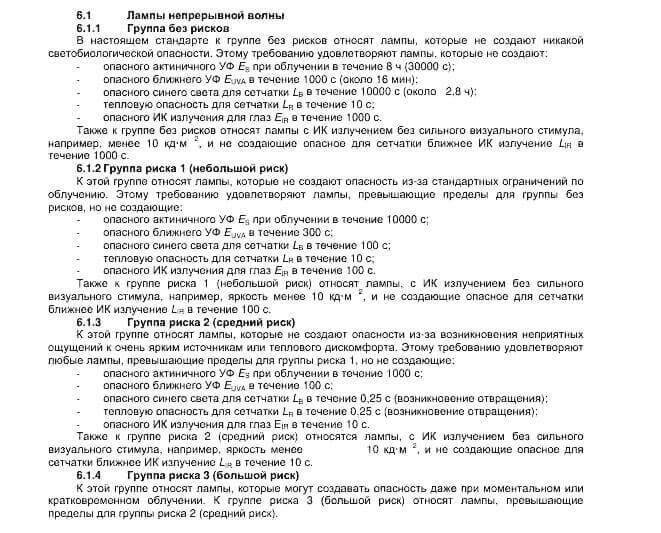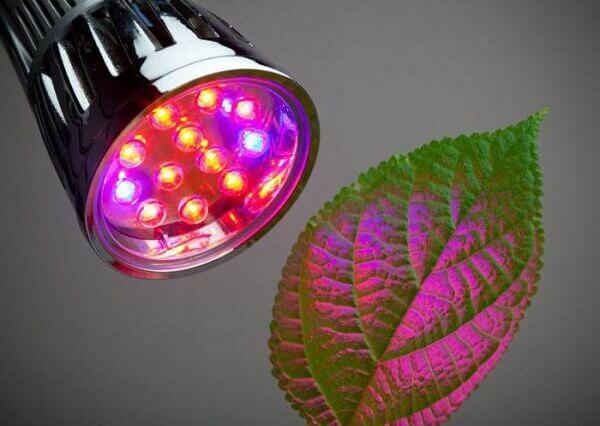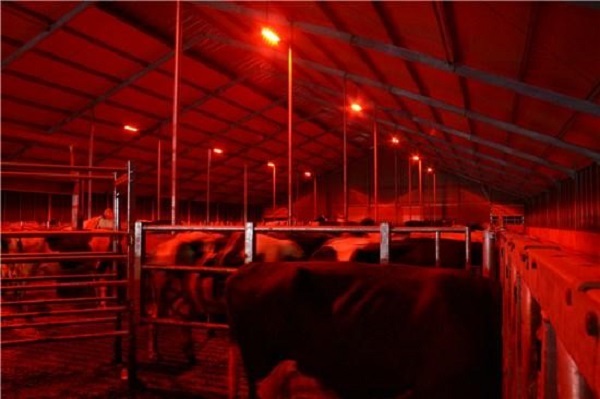In the market of lighting products, LED lamps, which outwardly resemble incandescent lamps with an E14 or E27 base, are gaining more and more popularity. The demand for LED bulbs is growing every year. LED sources have no analogues in terms of performance, energy efficiency and environmental safety. Despite the obvious advantages, there are opponents of the use of LEDs for lighting, who see the danger of LED lamps in their effect on the human body. Let us consider in more detail what harm is reality and what is from the voiced myth.
Content:
- Harmful substances in the LED lamp
- Dangers of LED lighting
- Hazard classification
- Influence on melatonin biosynthesis
- Damage from flickering lamps
- The danger of white light
- Electromagnetic radiation
- Use in crop production
- Application in animal husbandry
- Conclusion
Harmful substances in the LED lamp
To determine how environmentally friendly LED lamps are, consider what materials are used in their production.

The body is made of plastic, steel, aluminum alloys. The flask containing the diode board is not sealed and is not filled with toxic gases. The light bulb device includes a driver.
From the above, we can conclude that LED lamps are no more harmful than other electronic devices and can be disposed of as ordinary household waste.
Dangers of LED lighting
Research carried out by scientists has made it possible to find out that it is the radiation of LEDs that is dangerous. Wherein:
- harm is caused by blue and violet short-wave components of the spectrum;
- green light is less harmful;
- red does no harm to the human body.
LED bulbs have a negative effect on the retina of the eye. The injuries received can be:
- photomechanical (arise when exposed to a shock wave of light energy);
- photothermal (appear when tissue is heated during irradiation);
- photochemical (cause chemical changes under the influence of a stream of light).

Hence, it is dangerous to look at bright LED lamps. But the same conclusion can be made in relation to incandescent lamps or fluorescent lamps.
Manufacturers supply light sources with diffusers, shades giving soft light. Thanks to this, it is possible to significantly reduce the harm caused to human health by LED lamps.
Hazard classification
In order to correctly assess the harm of light radiation, it is necessary to refer to the regulatory documents. For example, the currently valid GOST R IEC 62471-2013 describes the parameters of photobiological safety of lamps and lamp systems, including LED devices.

Based on this standard, studies were carried out to establish that:
- the greatest harm to human health is caused by blue LEDs with a power of 15 W and above, they are classified as the third risk group;
- the danger of a blue spectrum diode with a power of 0.07 W is not great, it can be attributed to the first group;
- at the same color temperature, white LEDs have 20% more hazardous blue emission than other light sources;
- LED lighting used in everyday life can be attributed to risk group 2, if it is assumed that the danger of incandescent lamps is limited to the zero or first category.
Influence on melatonin biosynthesis
Melatonin is a biologically active substance (hormone) produced in the endocrine gland located in the human head. Influences metabolic processes and physiological functions of the body.
Scientists have proven that any bright light sources suppress melatonin secretion. But it is the intense light of the blue spectrum that is present in fluorescent and LED lamps that has a greater impact.

In this regard, a number of recommendations have been developed to reduce the harm resulting from the use of energy-efficient lighting sources. Scientists advise:
- use incandescent lamps for apartments, especially in chandeliers located in bedrooms;
- 2-3 hours before bedtime, avoid influencing the vision of any bright sources;
- working at a computer in the dark, use special glasses that do not transmit the blue spectrum of radiation;
- for night illumination in houses, use red lighting;
- use products only from well-known, well-known manufacturing companies;
- use LED lamps only in luminaires specially designed for them.
At the same time, for work in an office, it is preferable to have a cold spectrum of lighting, which tones up and increases a person's performance.
Damage from flickering lamps
The flickering frequency of 300 Hz of energy-saving lamps has a negative effect on the human nervous system. Its performance decreases, increases irritability and fatigue, hormonal levels are disrupted, circadian rhythms are lost.
But, if the voltage at the output of the driver undergoes additional high-quality filtering, freeing itself from the variable component, the ripple value will not exceed the permissible 10%. Therefore, it is better to purchase LED lamps with high-quality drivers, without saving on the cost of devices.
The danger of white light
Although there are white LEDs, there are currently no semiconductors that emit white light. It is obtained in two ways:
- combining red, green and blue LEDs;
- combining radiation of blue, violet, ultraviolet range and phosphor (photoluminescence effect).
Human eyes are most sensitive to the blue spectrum. Long-term radiation can lead to retinal degradation. White light is especially harmful to the eyes of children.
The inclusion of low-power incandescent lamps of 40 - 60 W, LED lamps of warm white light in a lamp with several cartridges will help to reduce the negative impact.

Get better devices Colour temperature which is in the range of 2700 - 3500 K. This emission spectrum is closest to sunlight at sunset. It is especially important to comply with these conditions for children, since the fragile body of a child is most vulnerable to adverse factors.
Electromagnetic radiation
LED light source drivers generate high frequency pulses, creating electromagnetic interference in the environment.
This fact can affect the operation of some electronic devices: radios, televisions, WI-FI transmitters. It is important to locate these devices no closer than 40 cm from the source of interference.
The harm from electromagnetic radiation from an LED lamp is much less than the harm from a mobile phone. The resulting danger is insignificant for a person, it can be neglected.

Use in crop production
Due to the lack of heating, LED lamps do not have a negative effect on plants, therefore they are actively used in additional lighting when growing seedlings of different crops. Even by placing the source just 1 cm from the shoots, you don't have to worry about thermal burns or the complete death of the crop.

The LEDs in the phytolamp combine several colors. Each has its own useful action:
- yellow supplies energy, starts photosynthesis;
- blue contributes to the development and strengthening of the root system;
- red improves seed germination, promotes the formation of inflorescences.
As the plant grows, the combination of the spectrum is adjusted according to the development period of the plant.
Application in animal husbandry
Light plays a vital role in animal life. The lack of natural light is easily compensated by LED lamps.
Using the variety of the color spectrum of diode sources, it is possible to influence the processes occurring in the animal's body, achieving an improvement in vital signs.

During the day, it is better to use short-wave radiation, causing, for example, a state of vigor in cows, which has a beneficial effect on the growth and maturation of young animals and on increasing milk production. At night, the indoor lights turn on red, which makes the animals sleep more restful.
Conclusion
Comparing the benefits and harms of LED lamps, we can conclude that they are significantly superior to other types of lighting devices in almost all respects, and the harm from their use is insignificant.
Related materials:
- Why are voltage dips in the network dangerous?
- What is the ripple of LED lamps
- Protected zones of power lines
Your e-mail will not be published. Required fields are marked *


